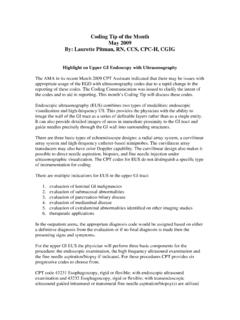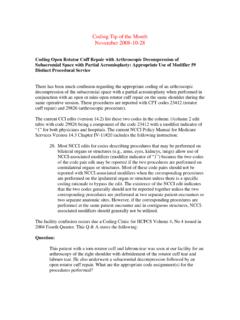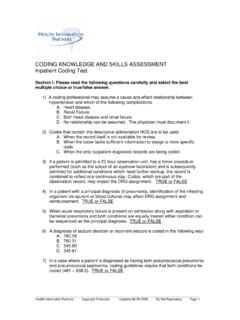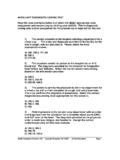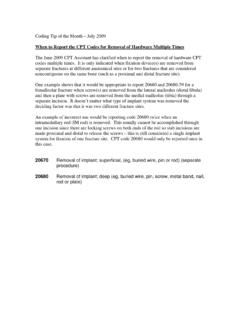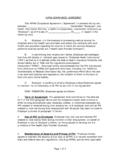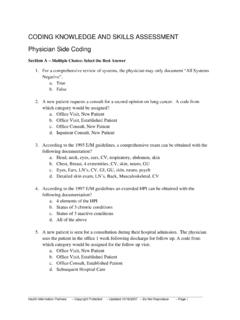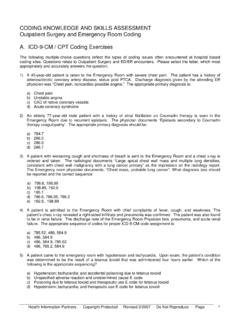Transcription of CODING KNOWLEDGE AND SKILLS ASSESSMENT Emergency …
1 CODING KNOWLEDGE AND SKILLS ASSESSMENT Emergency Room CODING A. ICD-9-CM / CPT CODING Exercises The following multiple-choice questions reflect the types of CODING issues often encountered at Hospital based CODING sites. Questions relate to ED/ER encounters. Please select the letter, which most appropriately and accurately answers the question. 1) A patient presents to the Emergency Department with chief complaints of dehydration , fever and severe diarrhea. The patient is given IV fluids. The attending physician documented Salmonella gastroenteritis on the Emergency room encounter form and signs it. Which of the following is the correct CODING and sequencing? a) , b) c) , d) , , 2) A patient with a history of alcoholic cirrhosis is seen in the Emergency Room of the hospital with hematemesis.
2 The appropriate primary diagnosis is: a) Alcoholic cirrhosis b) Gastric varix c) Hematemesis d) Esophageal varicies in diseases classified elsewhere without mention of bleeding 3) A 45-year-old patient is taken to the Emergency Room with severe chest pain. The patient has a history of arteriosclerotic coronary artery disease, status post PTCA. Discharge diagnosis given by the attending ER physician was Chest pain, noncardiac possible angina. The appropriate primary diagnosis is: a) Chest pain b) Unstable angina c) CAD of native coronary vessels d) Acute coronary syndrome 4) An elderly 77-year-old male patient with a history of atrial fibrillation on Coumadin therapy is seen in the Emergency Room due to recurrent epistaxis.
3 The physician documents Epistaxis secondary to Coumadin therapy coagulopathy . The appropriate primary diagnosis should be: a) b) c) d) 5) A patient is admitted to the Emergency Room with chief complaints of fever, cough, and weakness. The patient s chest x-ray revealed a right-sided infiltrate and pneumonia was confirmed. The patient was also found to be in renal failure. The discharge note of the Emergency Room Physician lists, pneumonia, and acute renal failure. The appropriate sequence of codes for proper ICD-9-CM code assignment is: Health Information Partners Copyright Protected - Updated 2/2007 - Do Not Reporduce - Page 1 a) , 486, b) 486, c) 486, , d) 486, , 6) A patient came to the Emergency room with hypotension and tachycardia.
4 Upon exam, the patient s condition was determined to be the result of a tetanus toxoid that was administered four hours earlier. Which of the following is the appropriate sequencing? a) Hypotension; tachycardia; and accidental poisoning due to tetanus toxoid b) Unspecified adverse reaction and undetermined cause E code c) Poisoning due to tetanus toxoid and therapeutic use E code for tetanus toxoid d) Hypotension; tachycardia; and therapeutic use E code for tetanus toxoid 7) The following ICD-9-CM index entries appear: Encephalitis infectious (acute) (virus) NEC postinfectious NEC [ ] The diagnosis listed by the physician is encephalitis after infection. Which of the following represents the correct CODING and sequencing? a) b) c) ; d) ; 8) Child presents to Emergency room accompanied by parents.
5 The patient has a large cm splinter lodged on the sole of his foot superficially, after playing on a wooden floor in his bare feet. The physician prepares the area with betadine, and pulls the splinter out with tweezers without making an incision. The appropriate CPT code is: a) An appropriate evaluation/management code for Emergency room services. (99281-99285) b) 28190 Removal of foreign body, foot; subcutaneous c) 10120 Incision and removal of foreign body, subcutaneous tissues; simple d) A and B 9) A cause-and-effect relationship between hypertension and which of the following conditions may be assumed? a) Chronic kidney disease b) Heart failure c) Neither condition d) Both heart and chronic kidney disease 10) Sickle-cell anemia and thalassemia are both types of: a) Iron deficiency anemias b) Hereditary hemolytic anemias c) Aplastic anemia d) Coagulation defectsHealth Information Partners Copyright Protected - Updated 2/2007 - Do Not Reporduce - Page 2 B.
6 Outpatient Emergency Room Case Examples Using Your CPT Book (Do not code the E&M visit CPT code): 1. A 7-year-old male patient comes to the ER with his parents, after falling out of a tree and landing on his left arm. He is complaining of pain in the left arm and tenderness. An examination is performed and a laceration is also noted on the left arm 2 in length, which is distant from the site of the pain. An x-ray is taken and demonstrates a fracture of the left forearm. The laceration is closed with steri-strips and a tetanus injection is given. The arm is put in a cast (forearm) by the ER physician and ortho tech. The patient is discharged to be followed up with the pediatrician in 7 days. Assign the correct CPT Code(s) :_____ 2. ER Procedure: Repair deep laceration of the right arm and shoulder.
7 Clinical Indication/Diagnosis: Deep laceration of right arm/shoulder from broken glass Technique/Details: A cm simple laceration was repaired on the right arm. A cm laceration on the shoulder was also repaired with extensive removal of glass. Assign the correct CPT Code(s): _____ 3. A 55-year-old patient with known GI problems come to the ER complaining of abdominal pain and feeling weak and faint. Lab work reveals a low Hct/hgb. The patient receives a blood transfusion of 2 units whole blood without any adverse effects. Assign the correct CPT code(s): _____ 4. A 16 year old patient comes to the ED/ER with a 4 cm laceration of the right hand due to a knife (while preparing food). Active bleeding is noted. The wound is cleansed with saline and examined.
8 The decision is made to repair the wound/laceration with sutures. Procedure: The wound was infiltrated with lidocaine as a local anesthetic. The physician uses nylon sutures to close the single-layer, simple 4-cm laceration without incident. Steri-strips are applied to the skin. The patient is given an injection of tetanus in the right arm and another injection of antibiotics SQ. Assign the correct CPT code(s): _____ 5. What is the appropriate E/M code for a new patient office visit in which a comprehensive history and comprehensive physical exam were performed and medical decision making was of high complexity? Select the correct E/M code:_____ Health Information Partners Copyright Protected - Updated 2/2007 - Do Not Reporduce - Page 3 C.
9 Emergency ROOM CASE STUDIES Emergency ROOM CARE CASE STUDY 1 Emergency ROOM REPORT CHIEF COMPLAINT: Laceration of leg HISTORY OF PRESENT ILLNESS: Patient was using a chain saw and lacerated his left leg. He is ambulatory to the Emergency Room. Medications: Insulin, Aciphex. Social History: He is married and lives with his family. REVIEW OF SYSTEMS: There is a laceration of the left calf. PAST MEDICAL HISTORY: Diabetes mellitus, pt takes Insulin. PYSICAL EXAMINATION: Vital signs are stable. There is a jagged 9 cm laceration to the left calf. Laceration extends through the skin. PROCEDURE: Cleansed the affected area. Infiltrated with a local anesthetic, and sutured with layered sutures of 4-0 Vicryl. He was placed in a knee immobilizer and given Ancef 1 gr IM.
10 ASSESSMENT : Laceration to the left calf, repaired with sutures PLAN: Continue with Keflex 500 mg po qid, Vicodin 1-2 q4h. See your physician on Monday for a wound check. Health Information Partners Copyright Protected - Updated 2/2007 - Do Not Reporduce - Page 4 Emergency ROOM CARE CASE STUDY 2 Emergency ROOM REPORT CHIEF COMPLAINT: Seizure HISTORY OF PRESENT ILLNESS: According to the family he had at least three seizures lasting at least three minutes and separated by intervals of five minutes with generalized shaking and loss of consciousness. An ambulance was summoned and he was found to be postictal thereafter with improvement in route to the hospital. There has been no prior history of seizures. PAST MEDICAL HISTORY: An 81-year-old male who does have a prior history of chronic renal failure, on dialysis three times a week.
